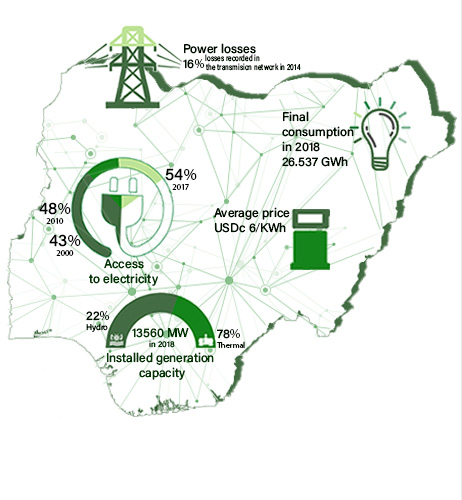- Your cart is empty
- Continue Shopping

Nigeria Economic Outlook
Economic growth in Nigeria slowed from 3.3% in 2022 to 2.9% in 2023 due to high inflation and sluggish growth in the global economy, which declined from 3.5% in 2022 to 3.2% in 2023. Growth was driven by services and agriculture on the supply side and by consumption and investment on the demand side. Inflation rose from 18.8% in 2022 to 24.5% in 2023, due to rising fuel costs and a depreciating naira. Petrol prices increased 167%, from naira 254 per liter in May 2023 to naira 671 in December 2023.
The exchange rate depreciated by 95.6% in 2023, resulting from the floating of the naira in June 2023. Monetary policy was tightened to control inflation, with the policy rate increased from 17.5% in January 2023 to 18.75% in December 2023. The fiscal deficit narrowed from 5.4% of GDP in 2022 to 5.1%, as general government revenues improved from 6.7% of GDP in 2022 to 7.6% in 2023, although remaining low. The deficit was financed mainly by domestic borrowing, including from the Central Bank’s Ways and Means. Public debt remained low at 40% of GDP in 2023, but the federal government debt service to revenue ratio was high, at 111%, due to weak revenues. The current account surplus improved from 0.2% of GDP in 2022 to 0.9% in 2023, driven by higher oil prices and exports. International reserves remained robust but dropped from 6.6 months of import cover in 2022 to 5 months in 2023, reflecting tight global financing conditions.
The poverty level remains high, with multidimensional poverty at 63% and income poverty at 40%. Income inequality is lower than in many middle-income countries, with a Gini coefficient of 0.35.
economic growth is projected to increase to 3.2% in 2024 and 3.4% in 2025, due to improved security, higher oil production, and stronger consumer demand. Inflation is expected to rise to 31.6% in 2024, driven by higher food prices and continued depreciation of the naira, before moderating to 20.7% in 2025 as inflationary pressures abate. The fiscal deficit, financed by domestic borrowing, is projected to narrow to 4.3% of GDP in 2024 and 4.1% in 2025 as both oil and nonoil revenues improve. The current account surplus is expected to improve to 3.0% of GDP in 2024 and 3.6% in 2025 due to higher oil exports. Headwinds include insecurity, lower oil production, rising fuel and food prices, and further exchange rate depreciation. Tailwinds include new oil production from the Dangote refinery, which is expected to lower energy prices as it starts supplying the local market.
Source: google
